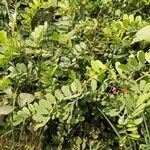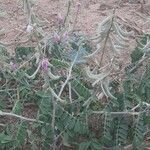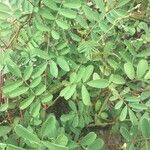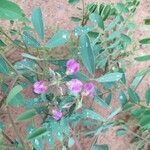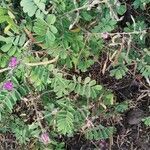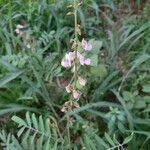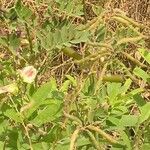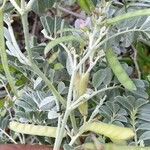Annual or perennial. Stems procumbent, ascending or erect, up to 70(100) cm high or sometimes (subsp. altissima) up to 150 cm, sometimes woody in the lower parts and forming a low bush, appressed or spreading-pubescent to densely white-or silvery-grey pubescent and sericeous. Leaves pinnate with (3)4-10(11) pairs of leaflets; petiole 0.1-3.5 cm long, petiole and rachis together (1.5)3-10(13) cm long; leaflets (0.5)0.8-4(4.5) x (0.2)0.3-1(1.3) cm, elliptic or obovate to oblong or oblanceolate, cuneate at the base, rounded to truncate at the apex; upper surface glabrous to silky, lower surface thinly appressed-pubescent to silky; stipules (0.5)1-8 x 0.2-1.5 mm, shortly triangular to linear-triangular. Flowers in terminal and leaf-opposed racemes 2-20(24) cm long; bracts 0.5-5 x 0.1-0.7 mm; pedicels 2-6(8) mm long. Calyx (1)2-4(6) mm long, appressed spreading-pubescent; lateral teeth approximately equalling the tube or rather longer. Petals (5)6-10 mm long, purple or pinkish. Staminal tube joined above. Ovary pubescent; style glabrous. Pods 26-60 x 4-6.5 mm, dark brown, shortly pubescent. Seeds (4)6-10(11), 3-4 x 2-2.5 x 1-1.2 mm, ± rhomboid or oblongoid, with a very small aril at the middle of one of the longer sides, not markedly closely packed, the distance between the centres of adjacent seeds being greater than the breadth of the pod.
Herbs, perennial, 30-60(-150) cm tall, many branched, puberulent, densely spreading villous, or glabrescent. Stems nearly erect to spreading, with a woody base, ridged. Leaves 9-17(-21)-foliolate; rachis 7-15 cm, including petiole ca. 1 cm; leaflet blades oblong-elliptic, oblanceolate-elliptic, or obovate-elliptic, 1.5-3.5(-4.5) × 0.4-1.5 cm, secondary veins 7-12 on each side of midvein, base narrowly rounded, apex obtuse, truncate, or retuse and cuspidate. Pseudoracemes terminal, opposite to a leaf or axillary near apex of branchlets, ca. 2 or 10-15 cm. Pedicel 2-4 mm, slender, slightly elongate in fruit. Flowers ca. 8 mm. Calyx 2-4 × ca. 3 mm; teeth equal. Corolla mauve; standard orbicular, white puberulent. Ovary with trichomes, with 5-8 ovules. Legume linear, 3-5 cm × 3.5-4(-6) mm, with sparse appressed trichomes, apically slightly curved. Seeds ca. 6 per legume, grayish brown, ellipsoid, ca. 3 × 1.5 mm, with or without spots, smooth or rough. Fl. Mar-Oct, fr. Sep-Dec.
An erect or scrambling herb. It can grow each year from seed or continue growing for a few years. It is 40-80 cm high. The stems can be hairy or smooth. The leaves have an odd number of leaflets. The leaves have 9-21 leaflets which are oblong and 2 cm long by 6 mm wide. They have a point at the tip. The flowers are 8 mm long in slender flower arrangements growing opposite leaves. These stalks can be 20 cm long. The flower standard is white inside and purple outside. The keel is green with a purple tip. The fruit are narrow pods curved upwards towards the tip. They are 4-5 cm long and 4-6 mm wide. They have short hairs. There are 6-9 seeds spaced more widely apart.
Leaves pinnate with (3)4–10(11) pairs of leaflets; petiole 0.1–3.5 cm long, petiole and rachis together (1.5)3–10(13) cm long; leaflets (0.5)0.8–4(4.5) × (0.2)0.3–1(1.3) cm, elliptic or obovate to oblong or oblanceolate, cuneate at the base, rounded to truncate at the apex; upper surface glabrous to silky, lower surface thinly appressed-pubescent to silky; stipules (0.5)1–8 × 0.2–1.5 mm, shortly triangular to linear-triangular.
Seeds (4)6–10(11), 3–4 × 2–2.5 × 1–1.2 mm, ± rhomboid or oblongoid, with a very small aril at the middle of one of the longer sides, not markedly closely packed, the distance between the centres of adjacent seeds being greater than the breadth of the pod.
Stems procumbent, ascending or erect, up to 70(100) cm high or sometimes (subsp. altissima) up to 150 cm, sometimes woody in the lower parts and forming a low bush, appressed or spreading-pubescent to densely white-or silvery-grey pubescent and sericeous.
Calyx (1)2–4(6) mm long, appressed spreading-pubescent; lateral teeth approximately equalling the tube or rather longer.
Flowers in terminal and leaf-opposed racemes 2–20(24) cm long; bracts 0.5–5 × 0.1–0.7 mm; pedicels 2–6(8) mm long.
Flowers purple or pink in very lax racemes with the lowest flowers appearing axillary and solitary
A variable perennial, 6–18 in. high, more or less erect, woody at the base
Pods 26–60 × 4–6.5 mm, dark brown, shortly pubescent.
Petals (5)6–10 mm long, purple or pinkish.
Ovary pubescent; style glabrous.
Staminal tube joined above.
Annual or perennial.
